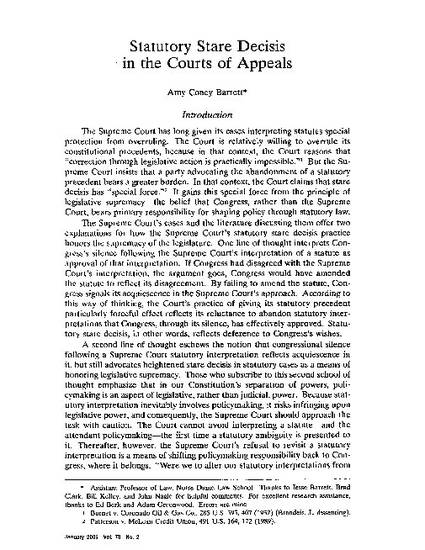
The Supreme Court has long given its cases interpreting statutes special protection from overruling. Two rationales exist for this practice. One line of thought interprets congressional silence following the Supreme Court's interpretation of a statute as approval of that interpretation. According to this way of thinking, a refusal to overrule statutory precedent is a refusal to veer from an interpretation that Congress has effectively approved. Another line of thought emphasizes that statutory interpretation inevitably involves policymaking, and that policymaking is an aspect of legislative, rather than judicial, power. According to this second way of thinking, the Supreme Court should refuse to revisit its statutory interpretations as a means of encouraging Congress (and other interested parties) to use the democratic rather than the judicial process to resolve the policy questions that lie at the heart of interpretive disputes.
A robust literature exists debating the wisdom of the Supreme Court's statutory stare decisis doctrine. That robust literature, however, has wholly overlooked a curious aspect of super-strong statutory stare decisis: the courts of appeals have adopted it too. Scholars of statutory interpretation have not noticed the appearance of this doctrine in the lower courts, and the logic of its presence there is not immediately apparent. In this Article, I explore whether statutory stare decisis is an example of an interpretive practice in which the Supreme Court and the lower courts should diverge. I argue that in the courts of appeals, as in the Supreme Court, the theory emphasizing the connection between statutory stare decisis and the separation of powers provides far more credible support for the doctrine than does a theory of congressional acquiescence. Nevertheless, even the separation-of-powers theory does not justify super-strong statutory stare decisis in the courts of appeals. To the extent that statutory stare decisis operates as a restraint on judicial policymaking, it does so based on assumptions about how Congress will react to the Supreme Court. It is both impractical and inconsistent with the system of appellate review that Congress has designed for the inferior courts to assume that Congress will respond to them in the same way. Whatever the merits of statutory stare decisis in the Supreme Court, I conclude that the inferior courts have no sound basis for following the Supreme Court's practice.
Available at: http://works.bepress.com/amy_barrett/8/

Reprinted with permission of George Washington Law Review.